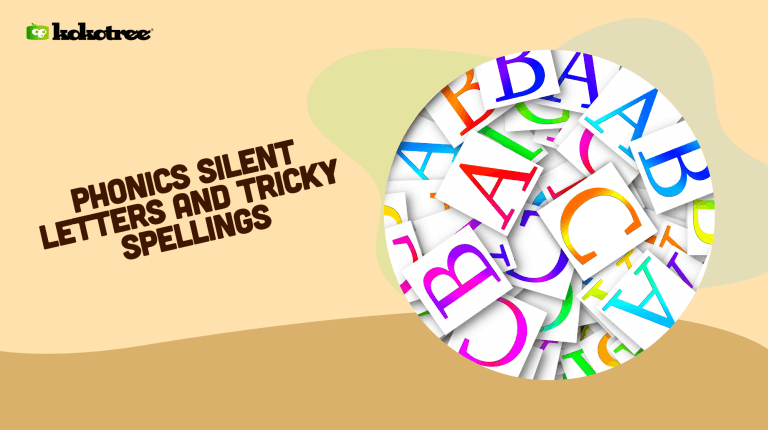

As a parent, teaching your child to read and write can sometimes feel like quite an adventure, especially when you encounter silent letters and tricky spellings! These pesky exceptions can make learning phonics a bit of a challenge for both you and your little one. In this blog post, we’ll explore the fascinating world of silent letters and tricky spellings, discuss some engaging activities and games to help your child recognize and remember these exceptions, and provide tips on how to support your child’s understanding of these unique spelling rules. Together, we’ll make learning fun, and soon, the silent letters and tricky spellings will be no match for your child’s newfound phonics prowess! 🚀
Silent letters and tricky spellings in phonics refer to the instances where certain letters in a word are not pronounced or when a word’s spelling does not align with its phonetic pattern. This makes it difficult for children learning to read and write, as it requires them to memorize these exceptions instead of following the standard phonetic rules. Helping children understand and remember these exceptions can be achieved through engaging activities, games, and consistent reinforcement during their early education.
Silent letters are letters that are a part of a word’s spelling but not pronounced when we say the word. They can confuse children when they learn to read and write, as they need to recognize the patterns and exceptions where these silent letters occur.
Some familiar silent letter patterns include:
By focusing on these common patterns, your child will have an easier time spotting silent letters in new words they encounter.
Tricky spellings are words that have confusing or irregular spelling patterns, which don’t fit the standard phonics rules. They present challenges for children because they defy the typical patterns they’ve been learning.
Two types of tricky spellings are homophones (words that sound the same but have different meanings and spellings, like read and reed) and homographs (words that are spelled the same but have different meanings and often different pronunciations, like wound as an injury and wound past tense of wind). Recognizing these words and their meanings will help your child master tricky spellings.
Teaching your child silent letters and tricky spellings can be enjoyable and effective with these fun activities and games:
Create a list of words with silent letters or tricky spellings and hide them around the house. Have your child search for them and read them out loud, emphasizing the silent letters or tricky spellings.
Using index cards, create pairs of words with silent letters or tricky spellings. Shuffle the cards, place them face down, and challenge your child to find the matching pairs by turning over two cards at a time.
Create bingo cards with various words containing silent letters or tricky spellings in each square. Call out the words, emphasizing the silent letters and tricky spellings, and have your child mark off the words they hear on their bingo card.
Combining your child’s traditional phonics lessons with a well-designed learning app for kids can help reinforce their understanding of silent letters and tricky spellings. Look for an app that focuses on phonics, offers engaging games, and provides ample practice opportunities for reading words containing silent letters and tricky spellings. By incorporating digital learning, you can increase your child’s mastery of these challenges in a fun, interactive way.
As your child navigates through the world of silent letters and tricky spellings, your support and guidance are essential for their success. Here are some tips to effectively support your child’s learning journey:
Remember that learning phonics is a process that requires time, effort, and patience. Encourage your child at every step, and celebrate their achievements—no matter how small they may seem—to foster a positive learning environment.
Practice makes perfect. Set aside dedicated time each day for phonics lessons, focusing on various silent letters and tricky spellings. Establishing a consistent routine will help your child internalize the concepts more effectively.
Create visual aids, such as posters or flashcards, that emphasize the silent letters and tricky spellings. Display them in your child’s study area or around the house, so they’re always visible and serve as a helpful reminder.
Make sure your child understands the meaning of the words they’re learning. Use them in sentences and engage your child in conversations that incorporate these words. Providing context helps solidify new concepts in their minds.
Keep track of your child’s progress and address any specific challenges they may be facing. Adjust the activities and games accordingly to cater to their unique learning needs.
By being an active participant in your child’s learning journey, you’ll help them gain confidence and develop essential reading and writing skills. With your support and guidance, silent letters and tricky spellings will become less intimidating, and your child’s phonics abilities will soar.
As you dive into the world of phonics, silent letters, and tricky spellings, you may have some questions about how to teach your child effectively and make it enjoyable for them. Below are answers to some frequently asked questions to help guide you in your educational journey.
Some common rules for silent letters include:
Teach your child these general rules as guidelines, but also make them aware of exceptions to these rules.
Help your child understand homophones by explaining that these are words that sound the same but have different meanings and spellings (e.g., there/their). Use example sentences to provide context, and create flashcards with the word pairs and their meanings for easy identification.
Incorporate games and activities into your teaching process, such as word hunts, memory matches, or silent-letter bingo. These engaging exercises will make learning fun while providing ample practice in identifying silent letters and tricky spellings.
Provide consistent encouragement, celebrate achievements, and maintain a positive attitude. Create a structured learning routine and break up the sessions with engaging activities and games to keep your child interested and motivated.
No, learning phonics is a complex process that requires time and plenty of practice. Be patient with your child, and make sure to adapt teaching methods as needed to support their understanding effectively.
Encourage your child to practice reading or writing on their own, and engage them in conversations using words containing silent letters and tricky spellings. You can also put up visual aids such as posters or flashcards to serve as constant reminders.
If your child is experiencing significant difficulties, consider seeking advice from a professional, such as a teacher or educational therapist. They can provide expert guidance and support tailored to your child’s unique learning needs.
There are many learning apps for kids that focus on phonics and can help reinforce their understanding of tricky spellings and silent letters. Look for apps that are engaging, interactive, and provide ample practice opportunities to enhance your child’s learning experience.
Children can typically begin learning phonics around the age of four or five. However, this can vary depending on your child’s readiness and developmental stage. Introduce silent letters and tricky spellings gradually as they progress in their phonics journey.
Establish a daily routine for phonics practice. Consistency is essential for mastering the concepts. Start with short sessions and gradually increase the duration as your child becomes more confident and engaged.
There is no one-size-fits-all approach, but many educators follow a systematic sequence, starting with basic letter-sound relationships and moving to more complex letter combinations, blends, and spelling patterns. Introduce silent letters and tricky spellings once your child has a strong foundation in phonics.
Context is crucial for helping your child understand the meaning and usage of words with silent letters and tricky spellings. Provide example sentences and engage your child in conversations using the words they’re learning to reinforce the new concepts.
With consistent practice, reinforcement, and support, most children gradually overcome the challenges associated with silent letters and tricky spellings. Adequate exposure to reading and writing will also help them develop a better understanding of these complex concepts over time.




